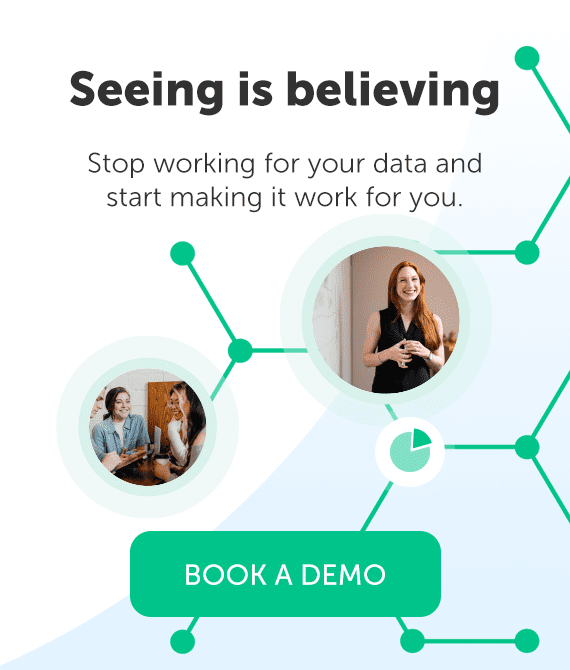What should your business development strategy look like if you want to win your next client, and the one after that? In professional services, the most effective business development strategy begins with relationships. The ones you have, the ones your colleagues have, and even the third-degree connections your firm can reach through trusted introductions. That web of connections is where new opportunities for growth take shape. The ultimate aim of mapping these pathways is simple: to consistently find new business in a smarter, more targeted way through warm introductions.
A relationship pathway is the chain of connections that links you or your colleagues to a target opportunity. Nearly 90% of client decisions involve two or more departments, which means opportunities are rarely driven by a single stakeholder. Success depends not only on offering the right expertise, but also on building trust and credibility across a broad decision-making group. This requires moving beyond ad hoc opportunities to systematically navigating the relationship pathways that connect your firm to target accounts.
This guide outlines a model for leveraging those pathways, moving from foundational techniques to advanced, proactive strategies that transform business development from unpredictable wins into a repeatable, data-driven growth framework.
Table of contents
Level 1 (the foundation): mapping your first-degree connections
The foundation of any business development strategy is the network you already have. Your first-degree connections are often the fastest route to new business, but most professionals only scratch the surface by relying on what’s in their inbox or who shows up in their LinkedIn feed.
If you turn to CRM, you’ll find you’re limited by the fact that it only shows the contacts that have already been logged. To see the full picture, you need visibility into the everyday interactions happening across the firm: the emails, meetings, and touchpoints that reveal where real relationships exist. That broader view connects the dots across colleagues and uncovers valuable client and prospect relationships that would otherwise stay hidden. Relationship mapping makes those connections visible and gives you a complete view of who has spoken to which client, when, and how often.
Best practice: go beyond your own inbox
Analyzing email and calendar data across the firm provides a clear, objective view of relationships that would otherwise remain hidden. This foundation strengthens any business development strategy by systematically surfacing warm connections instead of leaving growth to chance or to the limits of memory. These insights allow you to:
- Pinpoint the fastest paths to new business by identifying colleagues who already know your target contacts and can open doors.
- Avoid missed opportunities by seeing potential warm introductions across the firm before they disappear into someone else’s inbox or address book.
- Strengthen existing accounts by identifying connections that reach into new client divisions, geographies, or functions, helping you expand relationships and grow share of wallet.
- Spot hidden referral opportunities by connecting dots across colleagues’ networks that might otherwise remain siloed.
The goal: secure direct introductions
New pursuits or client opportunities rely on having already built a foundation of trust and trust builds faster through personal connections. With multiple decision-makers involved in every client opportunity, even a single introduction can create momentum. At this stage, the objective is to use relationship mapping to surface and activate those trusted connections and uncover referral opportunities as a proactive way to find new business, rather than leaving growth to chance.
Level 2 (the next step): leveraging shared experiences and connections
Second-degree ties are the connections of your contacts, such as a common alma mater, a former employer, or a seat on the same industry board. They are often overlooked because they don’t always show up in a CRM or LinkedIn search. Yet they can be some of the most effective forms of relationship mapping, because trust frequently stems from shared experiences. Once you’ve mapped your first-degree relationships, surfacing these connections provides the context and familiarity for natural openings that can turn a conversation into a client opportunity.
Best practice: look for shared history
Search for shared experiences that act as credibility boosters and create authentic reasons to reach out. These might come from professional overlaps, academic backgrounds, or even civic involvement. For example:
- A prospect’s CFO once worked at the same consulting firm as one of your senior partners, giving you a natural entry point.
- A potential client’s Head of Compliance serves on the same industry board as a colleague, providing a pathway to a warm introduction.
- An in-house counsel you’re targeting earned their MBA at the same business school as several people in your firm, making an alumni angle an easy opener.
- A CEO you want to reach is a member of an alliance which your partner is also a part of, giving you a natural reason to connect.
These second-degree connections are among the most effective sales prospecting techniques because they create familiarity and context so that your first conversation feels less like a pitch and more like a continuation of an existing relationship.
With this approach, you can:
- Build credibility through shared history by uncovering ties from past employers, alumni networks, or nonprofit boards.
- Expand visibility into spheres of influence by reaching senior stakeholders or peer executives who might otherwise be out of reach.
The goal: create non-obvious pathways
Your goal here is to find non-obvious connection points that competitors will miss. These shared experiences don’t just help you secure meetings, they also create opportunities to co-develop solutions with clients, invite prospects into thought leadership initiatives, and open up valuable referral opportunities into adjacent accounts or service lines. By focusing only on the most relevant second-degree links, you can make the best use of limited time, expand your influence across accounts, and consistently open doors to new growth opportunities.
Level 3 (the advanced playbook): proactively tracking your champions
Treat your network as a dynamic asset. The most advanced business development strategies recognize that your existing advocates don’t stand still as their careers progress. That’s why champion tracking, keeping tabs on where trusted contacts move next, is central to advanced strategies. Because at the heart of almost every successful pursuit is a champion on the client side: someone who already knows your value and is willing to advocate for you. The difference at this level is being proactive in monitoring developments in real-time.
Best practice: champion tracking as a growth lever
Your champions are the contacts who trust your expertise and understand your firm’s value, making them your most powerful pathways. But champions move. They change roles, get promoted, or join competitor and target organizations. With automated champion tracking, you can monitor these moves and can respond strategically at the right moment in time.
For example, imagine a tax partner sees that a long-time client contact has just stepped into a CFO role at a private equity–backed portfolio company. That moment is more than just a promotion, it also signals new advisory needs and shifting priorities. The right move is to acknowledge the transition, congratulate them, and use your shared history as a bridge to discuss the challenges they’re now taking on. Done well, this kind of outreach feels less like prospecting and more like a natural continuation of an established relationship. See more tips here.
With this approach you can:
- Spot new pursuits and client engagement opportunities the moment a trusted contact steps into a target account, creating the warmest possible pathway to find new business.
- Track when champions advance into leadership roles so you can align account strategies with the people who now hold budget and influence.
- Expand account coverage by seeing promotions and moves across client organizations, surfacing real-time opportunities to deepen relationships before competitors notice.
- Protect key accounts by detecting when a champion exits, so you can quickly reinforce relationships with other stakeholders.
How it works
Advanced platforms like Introhive help you identify your champions and monitor their career progression, whether that’s promotions, lateral moves, or transitions into target organizations.
Pathways works by identifying commonalities between contacts like overlapping work history, similar departments, seniority, or location. It then scores these overlaps, assigning a likelihood that the relationship is credible, and ranks the strongest paths into target accounts. In practice, you search for a contact or organization, apply filters like role or location, preview the suggested matches, and then request an introduction through the most promising pathway, streamlining outreach and helping you focus your efforts where they’re most likely to pay off.
Rather than discovering months later that a trusted contact has taken on a new role, Introhive lets you hear about moves early enough to reconnect while they’re still setting priorities.
The goal: turn champion moves into immediate wins
The aim at this stage is simple: convert champion moves into business development wins. A trusted contact entering a target account is the warmest possible pathway to a new client conversation. By engaging quickly, you can:
- Secure an inside advocate for a new client engagement opportunity at a target account.
- Uncover referrals into divisions you have not yet reached.
- Gain market intelligence that sharpens your pursuit strategy.
- Strengthen existing client relationships by showing attentiveness at pivotal career moments.
Without a champion, deals can stall. With one, you gain a trusted pathway into the right conversations at the right time.
Your pathways to growth: a summary of actionable plays
You’ve seen how relationship mapping evolves from the foundation to advanced strategies. Here’s how to put those levels into action across different roles:
- For new business: Leverage existing relationships for introductions or referrals to target accounts, fast-tracking new business opportunities.
- For referrals: Identify champions who can provide referral opportunities into new divisions.
- For hiring: Use relationship mapping to identify alumni or former colleagues at competitor firms who can connect you to top talent.
- For thought leadership: Find a shared connection to secure a speaking spot on a panel.
The firms that grow consistently are the ones that resist chasing every lead and double down on the opportunities most likely to convert. They do so by relying on the proven sales prospecting techniques outlined above that prioritize warm paths over cold outreach.
The technology that illuminates the path
Executing this playbook at scale requires more than manual effort. It requires visibility beyond your inbox, the ability to map connections across your firm, and proactive use of champion tracking to engage at pivotal career moments. Just as importantly, it means consistently uncovering referral opportunities that can extend your reach into new divisions or accounts.
With capabilities like pathways, relationship mapping, and champion tracking, Introhive empowers BD managers, partners, and key account managers alike to transform their business development strategy from reactive to proactive, moving beyond traditional sales prospecting techniques to consistently find new pursuits, expand accounts, and grow strategically.Your next client may already be one connection away. Explore our interactive demo to see Pathways in action, or book a demo with our team to learn how Introhive can help your firm find new pathways for growth.





